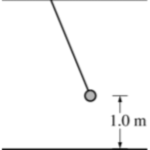0 attempts
0% avg
UBQ Credits
| Step | Derivation/Formula | Reasoning |
|---|---|---|
| 1 | [katex]PE_{\text{initial}} = KE_{\text{final}} + PE_{\text{spring, final}}[/katex] | Apply the law of conservation of energy. Initially, the climber has potential energy due to gravity, which gets converted into kinetic energy and the potential energy of the spring (the rope) when the climber is momentarily at rest. |
| 2 | [katex]mg(h + x) = \frac{1}{2}kx^2[/katex] | Express the potential energy due to height ([katex]mgh[/katex]) and potential energy stored in the stretched spring ([katex]\frac{1}{2}kx^2[/katex]), where [katex]m[/katex] is mass, [katex]g[/katex] is acceleration due to gravity (9.8 m/s2), [katex]h[/katex] is the original fall distance, and [katex]x[/katex] is the additional stretch in the rope. |
| 3 | [katex]84.4 \times 9.8 \times (0.627 + x) = \frac{1}{2} \times 1340 \times x^2[/katex] | Substitute the values [katex]m = 84.4\,kg[/katex], [katex]g = 9.8\,m/s^2[/katex], [katex]k = 1340\,N/m[/katex], and [katex]h = 0.627\,m[/katex] into the energy equation. |
| 4 | Solve for [katex]x[/katex] | Simplify and rearrange the equation introduced in Step 3 to form a quadratic equation in the standard form [katex]ax^2 + bx + c = 0[/katex]. Solve the quadratic using the formula [katex]x = \frac{-b \pm \sqrt{b^2 – 4ac}}{2a}[/katex]. |
| 5 | [katex]670x^2 – 825.712x – 515.7308 = 0[/katex] | Perform the calculation to get the quadratic equation: [katex]670x^2 – 825.712x – 515.7308 = 0[/katex]. |
| 7 | [katex]x \approx 1.688\,m[/katex] or [katex]x \approx -0.456\,m[/katex] | Calculate the roots, by graphing or using the quadratic formula. Note the negative root (approximately -0.456 m) is not physically meaningful since stretch can’t be negative. |
| 8 | [katex]x \approx \boxed{ 1.688\,m} [/katex] | The feasible physical solution is that the rope stretches about 1.688 meters when it brings the climber to rest. |
Just ask: "Help me solve this problem."
On a frictionless horizontal air table, puck A (with mass \( 0.249 \) \( \text{kg} \)) is moving toward puck B (with mass \( 0.375 \) \( \text{kg} \)), which is initially at rest. After the collision, puck A has velocity \( 0.115 \) \( \text{m/s} \) to the left, and puck B has velocity \( 0.645 \) \( \text{m/s} \) to the right.
A skier with a mass of 58 kg glides up a snowy incline that forms an angle of 28 degrees with the horizontal. The skier initially moves at a speed of 7.2 m/s. After traveling a distance of 2.3 meters up the slope, the skier’s speed reduces to 3.8 m/s.
In 3.0 minutes, a ski lift raises 10 skiers at constant speed to a height of 85 m. The ski lift is 55° above the horizontal and the average mass of each skier is 67.5 kg. What is the average power provided by the tension in the cable pulling the lift?
An object of mass 2 kg is thrown vertically downwards with an initial kinetic energy of 100 J. What is the distance fallen by the object at the instant when its kinetic energy has doubled?

A 0.5 kg pendulum bob is raised to 1.0 m above the floor, as shown in the figure. The bob is then released from rest. When the bob is 0.8 m above the floor, its speed is most nearly
1.688 m
By continuing you (1) agree to our Terms of Sale and Terms of Use and (2) consent to sharing your IP and browser information used by this site’s security protocols as outlined in our Privacy Policy.
| Kinematics | Forces |
|---|---|
| \(\Delta x = v_i t + \frac{1}{2} at^2\) | \(F = ma\) |
| \(v = v_i + at\) | \(F_g = \frac{G m_1 m_2}{r^2}\) |
| \(v^2 = v_i^2 + 2a \Delta x\) | \(f = \mu N\) |
| \(\Delta x = \frac{v_i + v}{2} t\) | \(F_s =-kx\) |
| \(v^2 = v_f^2 \,-\, 2a \Delta x\) |
| Circular Motion | Energy |
|---|---|
| \(F_c = \frac{mv^2}{r}\) | \(KE = \frac{1}{2} mv^2\) |
| \(a_c = \frac{v^2}{r}\) | \(PE = mgh\) |
| \(T = 2\pi \sqrt{\frac{r}{g}}\) | \(KE_i + PE_i = KE_f + PE_f\) |
| \(W = Fd \cos\theta\) |
| Momentum | Torque and Rotations |
|---|---|
| \(p = mv\) | \(\tau = r \cdot F \cdot \sin(\theta)\) |
| \(J = \Delta p\) | \(I = \sum mr^2\) |
| \(p_i = p_f\) | \(L = I \cdot \omega\) |
| Simple Harmonic Motion | Fluids |
|---|---|
| \(F = -kx\) | \(P = \frac{F}{A}\) |
| \(T = 2\pi \sqrt{\frac{l}{g}}\) | \(P_{\text{total}} = P_{\text{atm}} + \rho gh\) |
| \(T = 2\pi \sqrt{\frac{m}{k}}\) | \(Q = Av\) |
| \(x(t) = A \cos(\omega t + \phi)\) | \(F_b = \rho V g\) |
| \(a = -\omega^2 x\) | \(A_1v_1 = A_2v_2\) |
| Constant | Description |
|---|---|
| [katex]g[/katex] | Acceleration due to gravity, typically [katex]9.8 , \text{m/s}^2[/katex] on Earth’s surface |
| [katex]G[/katex] | Universal Gravitational Constant, [katex]6.674 \times 10^{-11} , \text{N} \cdot \text{m}^2/\text{kg}^2[/katex] |
| [katex]\mu_k[/katex] and [katex]\mu_s[/katex] | Coefficients of kinetic ([katex]\mu_k[/katex]) and static ([katex]\mu_s[/katex]) friction, dimensionless. Static friction ([katex]\mu_s[/katex]) is usually greater than kinetic friction ([katex]\mu_k[/katex]) as it resists the start of motion. |
| [katex]k[/katex] | Spring constant, in [katex]\text{N/m}[/katex] |
| [katex] M_E = 5.972 \times 10^{24} , \text{kg} [/katex] | Mass of the Earth |
| [katex] M_M = 7.348 \times 10^{22} , \text{kg} [/katex] | Mass of the Moon |
| [katex] M_M = 1.989 \times 10^{30} , \text{kg} [/katex] | Mass of the Sun |
| Variable | SI Unit |
|---|---|
| [katex]s[/katex] (Displacement) | [katex]\text{meters (m)}[/katex] |
| [katex]v[/katex] (Velocity) | [katex]\text{meters per second (m/s)}[/katex] |
| [katex]a[/katex] (Acceleration) | [katex]\text{meters per second squared (m/s}^2\text{)}[/katex] |
| [katex]t[/katex] (Time) | [katex]\text{seconds (s)}[/katex] |
| [katex]m[/katex] (Mass) | [katex]\text{kilograms (kg)}[/katex] |
| Variable | Derived SI Unit |
|---|---|
| [katex]F[/katex] (Force) | [katex]\text{newtons (N)}[/katex] |
| [katex]E[/katex], [katex]PE[/katex], [katex]KE[/katex] (Energy, Potential Energy, Kinetic Energy) | [katex]\text{joules (J)}[/katex] |
| [katex]P[/katex] (Power) | [katex]\text{watts (W)}[/katex] |
| [katex]p[/katex] (Momentum) | [katex]\text{kilogram meters per second (kgm/s)}[/katex] |
| [katex]\omega[/katex] (Angular Velocity) | [katex]\text{radians per second (rad/s)}[/katex] |
| [katex]\tau[/katex] (Torque) | [katex]\text{newton meters (Nm)}[/katex] |
| [katex]I[/katex] (Moment of Inertia) | [katex]\text{kilogram meter squared (kgm}^2\text{)}[/katex] |
| [katex]f[/katex] (Frequency) | [katex]\text{hertz (Hz)}[/katex] |
General Metric Conversion Chart
Example of using unit analysis: Convert 5 kilometers to millimeters.
Start with the given measurement: [katex]\text{5 km}[/katex]
Use the conversion factors for kilometers to meters and meters to millimeters: [katex]\text{5 km} \times \frac{10^3 \, \text{m}}{1 \, \text{km}} \times \frac{10^3 \, \text{mm}}{1 \, \text{m}}[/katex]
Perform the multiplication: [katex]\text{5 km} \times \frac{10^3 \, \text{m}}{1 \, \text{km}} \times \frac{10^3 \, \text{mm}}{1 \, \text{m}} = 5 \times 10^3 \times 10^3 \, \text{mm}[/katex]
Simplify to get the final answer: [katex]\boxed{5 \times 10^6 \, \text{mm}}[/katex]
Prefix | Symbol | Power of Ten | Equivalent |
|---|---|---|---|
Pico- | p | [katex]10^{-12}[/katex] | 0.000000000001 |
Nano- | n | [katex]10^{-9}[/katex] | 0.000000001 |
Micro- | µ | [katex]10^{-6}[/katex] | 0.000001 |
Milli- | m | [katex]10^{-3}[/katex] | 0.001 |
Centi- | c | [katex]10^{-2}[/katex] | 0.01 |
Deci- | d | [katex]10^{-1}[/katex] | 0.1 |
(Base unit) | – | [katex]10^{0}[/katex] | 1 |
Deca- or Deka- | da | [katex]10^{1}[/katex] | 10 |
Hecto- | h | [katex]10^{2}[/katex] | 100 |
Kilo- | k | [katex]10^{3}[/katex] | 1,000 |
Mega- | M | [katex]10^{6}[/katex] | 1,000,000 |
Giga- | G | [katex]10^{9}[/katex] | 1,000,000,000 |
Tera- | T | [katex]10^{12}[/katex] | 1,000,000,000,000 |
The most advanced version of Phy. 50% off, for early supporters. Prices increase soon.
per month
Billed Monthly. Cancel Anytime.
Trial –> Phy Pro
Try our free calculator to see what you need to get a 5 on the upcoming AP Physics 1 exam.
A quick explanation
Credits are used to grade your FRQs and GQs. Pro users get unlimited credits.
Submitting counts as 1 attempt.
Viewing answers or explanations count as a failed attempts.
Phy gives partial credit if needed
MCQs and GQs are are 1 point each. FRQs will state points for each part.
Phy customizes problem explanations based on what you struggle with. Just hit the explanation button to see.
Understand you mistakes quicker.

Phy automatically provides feedback so you can improve your responses.
10 Free Credits To Get You Started

By continuing you agree to nerd-notes.com Terms of Service, Privacy Policy, and our usage of user data.
NEW! PHY instantly solves any question
🔥 Elite Members get up to 30% off Physics Tutoring
🧠 Learning Physics this summer? Try our free course.
🎯 Need exam style practice questions? We’ve got over 2000.